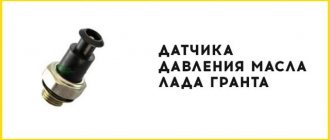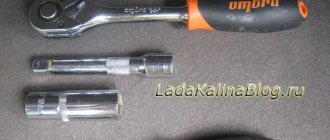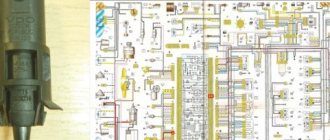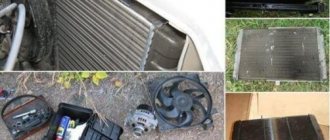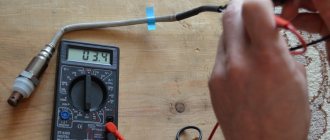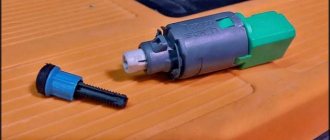The temperature sensor built into the VAZ-2115 allows you to avoid engine overheating, which means you will be able to keep an important component of the car safe and sound. The signal about engine overheating comes from the temperature meter sensor, but in domestic cars this device can hardly be called reliable.
Replacement
On an injection engine, which is literally filled with all kinds of sensors, sometimes you need to pay attention to the fan control. If the check shows that the device is faulty, there is nothing left but to carry out the replacement procedure
https://youtube.com/watch?v=IWO7xJG5zGY
The work requires only a few tools and materials:
- 30 mm socket wrench;
- Container for draining the cooling liquid;
- Dry rags.
Having prepared everything you need, you can start replacing.
The first priority is to let the engine cool. Working on a cold engine is more convenient and safer. If hot coolant comes into contact with your skin, burns will occur.
Dismantling process
To replace, you do not need an inspection hole or overpass. For such work, these elements are not needed. A simple garage will do. Disconnect the negative terminal from the battery. Drain all coolant from the radiator. Do not drain the coolant from the cylinder block; this is not necessary. Remove the plug from the expansion tank of the cooling system of your injection engine. To drain antifreeze or antifreeze, unscrew the drain plug on the radiator. You will find it at the bottom of the radiator, and no tools are required for dismantling. The plug is easily unscrewed by hand. Place a pre-prepared container under the drain hole where the coolant will drain. Wait until the fluid flow stops completely. If you want to refill the same antifreeze, take a clean container
If the coolant is old enough and needs to be replaced, then the cleanliness of the container does not matter. Screw the plug back in. Disconnect the contacts from the fan sensor. Using a 30 mm wrench, the regulator is unscrewed. Twist carefully so as not to damage the plastic radiator container. Screw the new regulator in place of the old one. Be sure to insert a copper spacer under the new device.
Copper gasket in place
- Reinstall the fan control wiring.
- Fill the expansion tank with pre-drained antifreeze or antifreeze.
- Purge the system to avoid the formation of air pockets inside the system.
- Replace the negative battery terminal.
- Turn on the power unit and warm it up for a while to make sure the new sensor is working.
- If, when heated to the desired temperature, the sensor does not work again, you should check other elements that may be causing this behavior of the cooling system.
Replacement without draining coolant
If you do not want to spend a lot of time replacing the sensor on your VAZ 2114, you can do without the procedure of draining the coolant.
Replacing the fan control switch without the coolant drain stage requires experience and certain skills. Therefore, it is not recommended for a beginner to use this repair method.
- Using a 30mm wrench, start unscrewing the old sensor, but not all the way.
- Prepare a new sensor.
- Unscrew the old regulator completely with one hand, and quickly insert the new one with the other.
- In this case, a certain part of the antifreeze will leak out, but this is not scary.
- After replacement, be sure to thoroughly wipe all areas around the regulator with a dry cloth.
- Make sure there are no leaks after installing a new device.
It is especially important here to work on a cold engine, since when heated and under pressure after removing the sensor, coolant can get on you. The consequences of skin contact with hot liquid are hardly worth describing. After completing the work, thoroughly wipe the car so that the coolant does not remain on the engine and its components
This is especially true for rubber and plastic elements.
When finished, dry the vehicle thoroughly to ensure no coolant remains on the engine or its components. This is especially true for rubber and plastic elements.
Loading …
How to remove the coolant temperature sensor
To dismantle the old DTOZH in the VAZ-2115 with your own hands and then put a new model in its place, you need to follow the step-by-step instructions:
- The DTOZH is located on the cylinder head cooling inlet pipe, so in order to remove the old device, you need to remove the air filter.
- Disconnect the negative cable from the battery.
- Place a container under the radiator and drain the coolant.
- Disconnect the wiring from the meter.
- Using keys 19 and 21, slightly loosen the tightness, and then unscrew the VAZ-2115 DTOZH.
Which sensor is confused with the one connected to the ECU?
The sensor showing the temperature of the VAZ-2115, the injector is often confused with the indicator of this temperature. The latest product is different in that it displays information on the instrument panel; it has no other functions.
The sensor we are talking about in this article, as mentioned above, affects the operation of the engine and even sets the time interval for injection to the injectors. Thanks to the device, the fan of the vehicle cooling system is switched on in a timely manner. Therefore, if you notice that you are using too much gasoline and the VAZ-2115 engine is literally boiling, it’s time to check the serviceability of the device.
You can watch a video on how to check the condition of the DTOZH with your own hands below: https://www.youtube.com/watch?v=x75bSRazxhQ
A visual video instruction on how to change the old antifreeze temperature sensor in a VAZ-2115 to a new one is shown below:
Principle of operation
The two-contact temperature sensor on the VAZ 2110–2115 family is a resistor mechanism with a negative temperature coefficient. That is, in the cold its resistance is high, and when heated, on the contrary, it is low. During operation, the DTOZ transmits impulses to the ECU. The device has 2 contacts: one for communication with the control unit, the second for starting/stopping the radiator fan.
Table 1. Units of measurement of water temperature and data on DTOZH VAZ 2115
| Degrees t°C | Resistance (Ohm) |
| 100 | 177 |
| 40 | 1459 |
| 0 | 9420 |
| −20 | 28680 |
| −40 | 100700 |
Information for self-checking with the meter
Simply put, the VAZ 2115 temperature sensor (8-valve injector) performs one of the functions of a damper (choke), which was traditionally located on carburetor cars. Having received readings from the DTOZH, the ECU system ensures that the cold engine is injected with a rich fuel mixture, and the hot engine is injected with a lean mixture.
This is interesting: Power steering oil on a Chevrolet Cruze: selection and replacement
Signs of breakdown
Based on certain signs, it can be determined that the IAC is out of order and needs to be repaired or completely replaced with a new device.
These signs include:
- Floating idle speed;
- Problems with starting the engine; it starts with difficulty even with the gas pedal pressed;
- It is not possible to increase the speed even when the engine has warmed up sufficiently;
- The engine suddenly begins to stall when shifting into neutral;
- The speed decreases when you turn on energy-consuming devices - stove, air conditioner, audio system, headlights, etc.
https://youtube.com/watch?v=nBlCBIkFob8
But replacing the regulator is not always the right decision. In some cases, removing the old sensor and installing a new device in its place will not bring any results. And all because the culprits of the malfunction may be other elements, such as spark plugs or a fuel filter.
Functionality check
If the engine stalls, the speed fluctuates, or turns out to be high, you must definitely check whether the IAC is working.
To check, you will first need to dismantle the fastenings of the throttle assembly, and then carefully move it literally 10 millimeters.
https://youtube.com/watch?v=SSl-Wq7x-SU
You will need a voltmeter with which you can check whether there is voltage going to the sensor and what its indicators are. In advance, connect the negative terminal from the battery to ground, and connect the voltmeter to the terminals marked with the letters A and D. Next, check the table.
| Indications | What do they mean |
| The voltmeter shows less than 12V | This means that the battery is most likely dead. |
| There is no data on the meter | The problem should be looked for in the wiring circuit or in the electronic engine control unit |
| Voltmeter shows 12V or more | Be sure to check the idle air control resistance. There are problems with him. The tester is connected to 4 pins. Normal resistance readings are 50 or 55 ohms |
Additionally, do a pairwise check. In this case, the resistance should be infinitely large. If the XX sensor shows different numbers, then the regulator requires mandatory and immediate replacement.
There is another way to check the functionality of the device. To do this, you need to remove the sensor and connect the block. Press the needle with your finger and watch it extend. When the ignition is turned off, the needle should push.
If there is no shock, you can still try to solve the problem by simply cleaning the device. Use a universal and all-powerful product called WD40. Wet the entire mechanism thoroughly with it and, armed with cotton swabs, clean everything you can get to.
When cleaning, pay special attention to the needle and stem
If these measures do not help, there is nothing else left but to replace the IAC.
Electronic engine control unit
The engine control unit is a kind of head control center for the entire car. This device processes all the readings provided by the vehicle’s sensors, regulates the engine control process, determines the required fuel and air ratios, generates a spark supply to the desired cylinder, and much more. The ECU is located inside the car, under the dashboard.
How to replace it yourself
Preparatory stage:
- Open-end wrench set to “19”;
- Rags;
- Additional lighting as needed;
- New "measuring device".
Replacement algorithm:
- We install the VAZ 2114 in the perimeter of the repair area;
- We turn off the engine, open the hood;
- We provide priority safety measures: block the rear row of wheels with wheel chocks, squeeze the parking brake;
- Remove the terminals from the DTOZH, unscrew the sensor with a key;
- We replace the device with a new one, screw it in, and put on the power terminals again.
We turn the key in the ignition, activate it, and check the functionality of the equipment. Add the missing amount of antifreeze as needed.
Recommendations for preventing problems with DTOZH
Some simple tips to help extend the life of your device are listed below.
- Purchase sensors with standard technical characteristics specified in the vehicle’s operational passport.
- At the slightest suspicion of a unit malfunction, carry out diagnostics.
- Follow the operating requirements recommended by the meter manufacturer.
The composition of antifreeze also affects the performance of the device. Therefore, you should periodically check its quality and quantity in the system.
What temperature sensors are installed on the VAZ 2115
Modern cars are equipped with controllers to receive data of a certain content and send impulses to the electronic control unit for further processing and decision-making. Sensors are used in almost all systems and mechanical components of a vehicle to monitor:
- temperature of the environment in the system;
- amount of fuel;
- air pressure and flow;
- exhaust gas composition;
- outside air temperature.
There are not many temperature sensors installed in the VAZ 2115 car.
DTOZH (coolant temperature sensor).
It is characterized by simplicity of design and durability. It is a resistor that changes the resistance value depending on fluctuations in the temperature of the liquid phase: at low temperature readings, the resistance will be high and, vice versa.
The electronic unit uses information received from the thermostat to control the crankshaft speed and the air-fuel mixture ratio, as well as to select the ignition timing.
In most cases, temperature sensors fail due to internal problems, sending false information to the control unit. This can lead to problematic engine starting and incorrect operation of the machine in idle mode.
The thermocouple is a thermistor, providing information about the state of the antifreeze. When the element is strongly heated, its resistance sharply decreases, and when cooled, on the contrary, the resistance value will increase. The sensor is located next to the cylinder block near the thermostat. The impulse from the controller is transmitted to the car’s on-board computer and the radiator cooling fan.
Possible reasons for a non-functioning coolant temperature sensor:
- contact break inside;
- violation of tightness;
- breakage of supply electrical wires. They can be caught by a cable coming from the gas pedal at a very close distance.
As a result, the ECU assumes a decrease in temperature and gives an indication to pump in additional air. And after a while the driver will receive a message about antifreeze overheating. A faulty sensor in hot weather, giving false information to the unit, can cause a decrease in engine performance or its complete stop.
Mass air flow temperature sensor (MAF).
Another important monitoring device is the engine mass air flow sensor. It is installed directly in the fuel system of the power plant, namely in the incoming fuel line.
Most car owners consider this sensor to be the most important because it is responsible for proper fuel injection. If this element begins to act up, then the light on the dashboard starts to light up.
The main signs by which a sensor is judged to be faulty:
- reduction in engine power level;
- drop in speed when driving;
- fuel consumption increases;
- malfunctions in the power plant.
You can determine whether the device is operating correctly in the following ways:
- disconnecting the device from the system;
- during external examination;
- using a multimeter.
Often, the presence of contamination inside the device is a direct sign of a malfunction. As a rule, the problem occurs when the car owner forgets to change the air filter on time. Oil leaks also significantly reduce the life of the controller.
Then it is necessary to dismantle the sensor itself. It's easy to replace the sensor. Simply unplug the connector.
Although the sensor cannot be repaired, some drivers manage to clean it. To do this, you will need a soft brush, a Phillips screwdriver and carburetor cleaner.
DNTV
It was securely hidden behind the front bumper of the car, so much so that not every experienced driver is able to immediately detect it. It has the same functions as DTOZH and measures the air temperature “outside” the car.
| Gearbox type | Price in rubles | Price in rubles |
| New | Major renovation | |
| 01M | From 150000 | From 89000 |
| TF-61SN, TF-62SN | From 150000 | From 85000 |
| DQ250\02E, DQ500 (0BH\0BT) | From 150000 | From 88000 |
| *price indicated as of April 2021 |
Summary
The coolant temperature sensor is an important element for the balanced operation of the VAZ 2115 engine. If it malfunctions, the car loses its driving characteristics: it starts poorly, stalls, loses power, consumes more fuel, and sometimes the engine does not work at all. You can replace the DTOZH yourself using a minimal set of tools.
TOZh sensors, from left to right: 1 Sensor for the fan, 2 sensor for the pointer, 3 a cleverly crafted old sensor of mine.
The conclusion is this: there are two temperature sensors - one for the “brains”, the fan, the on-board computer. (It screws in vertically, is easy to change, costs a little more. - the second one is on the arrow (single-pin, screwed horizontally under the pipe), behaves strangely when screwed in.
Now I will look for and ask for a sensor like my old one (in the photo with an orange neck). He gave me temperature readings exactly the same as on BC.
Causes of failure of the coolant temperature sensor
Structurally, the coolant sensor is quite simple, and accordingly, it rarely fails. Usually this happens simply due to its old age or mechanical damage. For example, corrosion of contacts and metal parts of the case may occur due to the fact that instead of antifreeze or antifreeze, ordinary water was poured into the cooling system (and even more so if this water is “hard”, that is, with a high content of metal salts). Also, the reasons for the failure of this device may be:
- Damage to the body. This can be expressed in various aspects. Often, leaks of coolant are visible, which flows from the threads of the sensor or its housing. Also, the electrical contacts and/or the thermistor itself may be damaged, which will produce an incorrect signal.
- Oxidation of contacts. Sometimes situations arise when, under the influence of fumes or simply from old age, the contacts on the sensor oxidize, so the electrical signal does not pass through them.
- Damage to the chip. In some cases, due to mechanical damage, the so-called “chip” may fail, that is, a group of contacts that is connected to the coolant temperature sensor. Simply put, the wires at the base of the connector fray. According to statistics from reviews found on the Internet, this is one of the most common malfunctions that occurs with the sensor and the corresponding system.
- Lost electrical contact inside the sensor. In this case, unfortunately, repair is hardly possible, since usually its body is sealed and does not allow access to the insides of the DTOZH. Accordingly, in this case the sensor only needs to be replaced with a new one.
- Violation of wire insulation. In particular, we are talking about the power and signal wires that go to the sensor from the electronic control unit and back. The insulation can be damaged due to mechanical stress, abrasion, or even simply from old age, when it “peeles” in pieces. This is especially true for those machines that are operated in conditions of high humidity and sudden changes in ambient temperature.
If it is possible to simply clean the body/threads/contacts of the sensor, then to restore its normal operation it is enough to carry out the appropriate measures. However, if the housing is damaged and/or the internal thermistor is damaged, then repair is hardly possible. In this case, you just need to replace the sensor with a new one. Its price is low, and the replacement process is simple and will not take much time and effort even for novice car owners.
How to check the serviceability of a part
After starting the internal combustion engine, the oil pump pumps fluid to all engine systems. From the crankcase through the filter, oil is supplied to each part, and the pressure gradually rises to operating condition. The light on the instrument panel lights up when there is insufficient pressure in the system. If the indicator does not go out longer than usual, then it is worth checking whether the sensor is working properly.
But a long-burning light can also indicate problems with low pressure due to other parts:
- The oil filter is clogged with dirt. The liquid entering the system is insufficient. The pump cannot create the required pressure. In this case, it is worth cleaning the filter and replacing it with a new one.
- Carbon deposits, which are washed away by oil from inside the engine, can also accumulate on the oil pan, clogging the oil receiver mesh and reducing its permeability. It is better to drain the lubricating fluid from the crankcase. If contamination is severe, replace with new oil.
- Oil pump malfunction.
- High wear of engine parts, in particular the crankshaft.
- Poor quality oil is poured - it is worth buying proven brands recommended by the car manufacturer (semi-synthetic 10W-40, volume - 3.5 l).
- Insufficient fluid level in the system - checked when the engine is cold with a dipstick, solved by adding oil.
If these reasons are considered, and the lamp on the panel is on, then the problem is a malfunction of the DADM (emergency oil pressure sensor) or the wiring from the device to the indicator. To check the device, you need to know where the faulty oil pressure sensor is located on the VAZ 2114. The part is located under the decorative cover of the internal combustion engine (internal combustion engine) on the left side of the engine compartment. The device is installed near the timing belt (gas distribution mechanism), on the right in the cylinder head (cylinder head), below the valve cover.
To professionally check the performance of the emergency oil pressure sensor, it is recommended to take the car to a specialized service station. But this is not always possible. Therefore, you need to know how to check the oil pressure sensor yourself. There are several options here:
- Visual inspection of the part - smudges in the place where the device is fixed may indicate a problem with the sealing washer. It is necessary to replace the ring and wipe the installation site. The fastener also leaks in the event of a malfunction of the excess pressure relief valve in the oil pump (the pressure in the system is above 0.8 atmospheres). If signs of a leak are found at the terminal attachment point, this clearly indicates the need to replace the sensor itself.
- The sensor is unscrewed and a pressure gauge is installed in its place. It is necessary to start the car engine and monitor the readings at idle speed. At normal oil pressure in the system, the parameter will be within 0.65 atmospheres. This indicates a faulty part.
- Without starting the internal combustion engine, with the sensor removed, it is necessary to crank the starter. Splashes from the device mounting hole indicate the presence of pressure in the system. But in this way it is impossible to find out its parameters.
- A new sensor is installed in place of the old device. If it works correctly, then the old device is faulty.
The oil pressure sensor on the VAZ 2114 cannot be repaired. But the low cost of the part will allow you to simply replace it with a new product.
In any case, if the pressure in the oil system is low or completely absent, it is not recommended to drive the car any further. This could lead to a serious problem with the engine.
Radiator
Digital engine temperature sensor
If, when inspecting the hoses, no problems are found and everything is dry, we move on - the radiator. Radiators often have defects caused by engine overheating. Such situations occur more often in the summer, but the consequences appear in the winter. In the heat, in a traffic jam, the engine begins to warm up and does not have time to be cooled by the flow of incoming air (there is none), the temperature rises and the expansion tank may not have time to relieve excess pressure in the system through the plug; accordingly, a microcrack (and more than one) appears in the radiator, which is not visible, but coolant may leak through it.
Moreover, the property of the liquid is such that it greatly changes its density when the temperature changes and begins to flow through small holes only in a cold state, that is, in the summer this problem may not manifest itself at all. A problem with a faulty radiator can be diagnosed by the presence of fluid under the front bumper, and localized and a solution can only be made on a lift or pit. Now a special additive is introduced into the coolant, which glows in ultraviolet light and the location of its leak can be easily and quickly detected thanks to this effect.
Do-it-yourself replacement of the VAZ-2114 coolant temperature sensor
Replacing the DTOZ is not difficult if the vehicle owner knows the design of the system designed to cool the engine fluid. In the 2114th model, the meter is located at the outlet of the motor, in the regular place of the outer contour of the thermostat housing.
For dismantling, the car owner will need the following tools and materials;
- wrench No. 19, an ordinary open-end wrench is sufficient;
- new and working DTOZH;
- if needed for replacement, use fresh antifreeze;
- if necessary, an additional light source may be needed;
- WD-40 lubricant;
- rags.
All work is carried out after complete cooling of all systems and components of the vehicle. The process takes place in the following order.
- Turn off the ignition and disconnect the battery from the terminals.
- Drain antifreeze to the level of the sensor. If the condition of the fluid is unsatisfactory, it will not cool and is completely removed from the system.
- To gain access to the device, the air filter is removed.
- At the output of the meter, the power supply wires are removed.
- Rozhkov No. 19 twists the DTOZH. Very often the threads “stick” to each other and it becomes difficult to disconnect the product. In such cases, penetrating lubricant comes to the rescue.
Installation of a new device is carried out in the reverse order of the above steps. On average, everything takes up to 15 minutes.
Purpose of dpkv
The crankshaft sensor on the VAZ 2115 belongs to the engine electrical control system. Based on the controller readings, the ECU arranges the ignition and the order of supply of the fuel mixture. DPKV, the second name of the element is a position sensor, monitors and transmits to the ECU the location of the crankshaft at any time. By processing information about the angular velocity and the frequency of its rotation, the ECU determines the moment of passing dead spots in the cylinders and calculates the operating mode of the following systems:
- ignition supply for each cylinder;
- injector opening time;
- gas distribution correction;
- control of adjacent systems of the output path, muffler, etc.
Crankshaft sensor 2115, an important component for the correct operation of the internal combustion engine, a faulty element leads to serious engine damage. Since the Lada Sputnik is equipped with injection engines, the part generates a signal to supply the ignition and to open/close the injectors; for carburetor engines, the unit only regulates the ignition operation. The sensor is located directly next to the crankshaft master or synchronization disk; the controller is mounted on a bracket screwed to the oil pump cover.
Lada 2003 - electronics
Nizhnevartovsk
Lada 2115 Samara, 2003
110 000 ₽
Slavgorod
Lada 2115 Samara, 2010
153 000 ₽
Nizhny Novgorod
Lada 2115 Samara, 2006
94 888 ₽
Yaroslavl
Lada 2115 Samara, 2007
70 000 ₽
See more cars on Drome
Participate in the discussion can only registered users.
Login Register
Replacement
Before repairs, it is necessary to carry out a number of preparatory measures. First, you should choose a level area for the machine. It can be in the garage, it can be outdoors. Secondly, prepare the tool: open-end and ring wrenches (19 mm, 13 mm, 10 mm, 8 mm). You will also need a capacious medical syringe of 100–250 ml, a 15–20 cm dropper tube and a 0.5–1 liter jar (so as not to drain the antifreeze/antifreeze). The sequence of actions is as follows:
- We wait until the engine cools down completely.
- Use a syringe to pump out the coolant from the expansion tank (100–200 ml).
- Unscrew the negative terminal of the battery (10–13 mm wrench).
- Unscrew the air filter housing fasteners (8 mm wrench).
- Carefully tilt the “pan” to the right.
- Disconnect the power supply from the DTOZH.
- We unscrew the sensor (19 mm wrench).
- We clean the landing area from dirt.
- We screw in the new DTOZH.
The assembly must be done in reverse chronology. There is no need to use sealant, since the copper O-ring fits perfectly and seals the connection. Let's start the engine. We check its operation and inspect the repair area for antifreeze leaks. The entire event takes 15–20 minutes.
Inspection and repair
If you need to check the device, then take a small piece of rubber hose. On the one hand, a special adapter is attached to it, which corresponds to the diameter of the pump outlet, and on the other, an emergency engine oil pressure sensor. We begin to create artificial pressure using a pump. Be sure to record these pressure/resistance ratios. If the sensor readings and its characteristics match, then the device is working.
There is another way to check the sensor. You need to place it in a foam solution with a lot of soap. Hold the sensor there for a while. Take it out and connect it to the pump. Pressurize the device using a pumping unit. If bubbles come out of the folded joints, the device is unusable and leaks oil.
But if you are convinced of a malfunction, you need to replace the detector. The emergency oil pressure sensor for an eight-valve engine is located on the right side of the engine, and for a sixteen-valve engine it is on the left. Its location may vary depending on the model and make of the car. To remove it, use our instructions:
- Disconnect the wire from the sensor that goes to the dashboard;
- There is a thread underneath the sensor, so carefully unscrew it with a wrench. If it is torn off, then try to remove it using pliers;
- Afterwards you just need to remove the sensor from the hole.
Immediately inspect the aluminum O-ring. This may be the cause of oil leakage. Depending on the diagnostic results, you will need to buy either a new sensor or replace the seal. The process of installing a new device is the opposite of removing it. Be sure to check the tightness of the connection between the warning lamp and the oil alarm sensor. At the same time, the method of removal and connection largely depends on the brand of the alarm and the model of the car.
Photo - replacing the emergency oil pressure sensor
Sometimes the problem may lie in the way the sensor is installed. For example, the Land Cruiser Diesel is known for the fact that the device can “fall” into the pan, causing it to give incorrect readings. Sometimes the circuit has oxidized or the computer control wire for the detector has simply broken. Also, if the sensor is crooked, it may incorrectly measure the pressure level due to deformation of the membrane.
